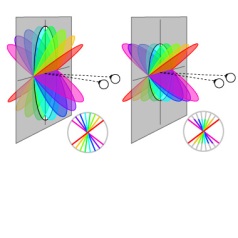 Responses to binocular disparity are widespread throughout the visual, temporal and parietal cortices. However, the circuits that transform local binocular disparities to coherent three-dimensional (3D) representations remain unknown. We use human fMRI to test for cortical areas that represent global 3D surfaces as opposed to local disparities. We measured fMRI responses while participants viewed random dot stereograms depicting slanted planes. Using multi-voxel pattern classification analysis, we find that (i) slant can be decoded reliably across visual areas and (ii) there is pronounced fMRI pattern-tuning for slant in early visual (V1, V2) and dorsal (V3, V3A) areas. Furthermore, we find that fMRI responses in area V3A are highly similar when the same slant is depicted, irrespective of changes in spatial extent or overall disparity of the stimuli. However, this is not true in areas V1 and V2. Moreover, opposite slants evoke highly dissimilar responses in area V3A, while there is some similarity between responses in V1. Together these results suggest V1 and V2 responses relate to low-level features (disparity-defined edges and distribution of disparities) while responses in V3A are compatible with the representation of surface slant.
Responses to binocular disparity are widespread throughout the visual, temporal and parietal cortices. However, the circuits that transform local binocular disparities to coherent three-dimensional (3D) representations remain unknown. We use human fMRI to test for cortical areas that represent global 3D surfaces as opposed to local disparities. We measured fMRI responses while participants viewed random dot stereograms depicting slanted planes. Using multi-voxel pattern classification analysis, we find that (i) slant can be decoded reliably across visual areas and (ii) there is pronounced fMRI pattern-tuning for slant in early visual (V1, V2) and dorsal (V3, V3A) areas. Furthermore, we find that fMRI responses in area V3A are highly similar when the same slant is depicted, irrespective of changes in spatial extent or overall disparity of the stimuli. However, this is not true in areas V1 and V2. Moreover, opposite slants evoke highly dissimilar responses in area V3A, while there is some similarity between responses in V1. Together these results suggest V1 and V2 responses relate to low-level features (disparity-defined edges and distribution of disparities) while responses in V3A are compatible with the representation of surface slant.

